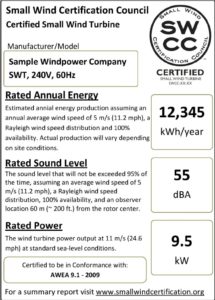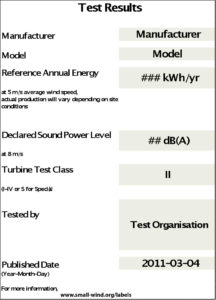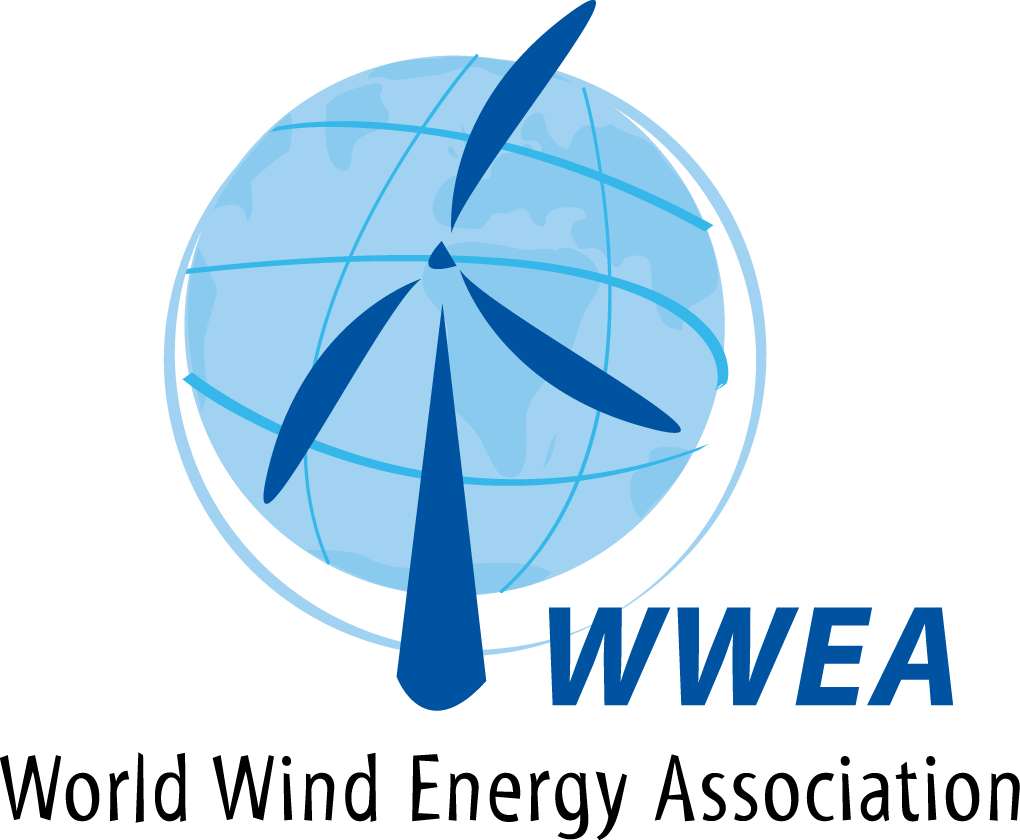As part of the effort to ensure quality, standards providing a set of design and engineering criteria to verify and assess performance are used to test wind turbines at facilities that provide site, equipment, and technical expertise. SWT are tested and an accredited third party verifies test results and provides certificates to manufacturers that meet the requirements of the Standards.
Standards & Certification
| Country | Standard |
|---|---|
| International | IEC61400-2 |
| Canada | Canadian Wind Turbine Codes and Standards |
| Japan | JSWTA Standard (JSWTA 0001:2013. Revised 2013.06.01) |
| Netherlands | Regeling Groencertificaten Elektriciteitswet |
| United Kingdom | RenewableUK Small Wind Turbine Standard (formerly BWEA Small Wind Turbine Performance and Safety Standard) |
| United States of America | AWEA Small Wind Turbine Performance and Safety Standard |
| Country | Certification Services |
|---|---|
| Denmark | Danish testing & certification association for wind energy DTU |
| Netherlands | CertiQ |
| United Kingdom | Microgeneration Certification Scheme (MCS) |
| United States of America | Small Wind Certification Council (SWCC) |
| Independant | GL |
| Independant | DEWI-OCC Offshore and Certification Centre |
| Independant | TÜV |
Consumer Labels
IEC Consumer Label
IEA Wind organized Task 27 Consumer Labeling of Small Wind Turbines. Beginning in 2009, Task 27 in liason with IEC TC88 MT2 developed and IEA Wind approved (in 2011) simplified standard tests and a label to provide understandable information on small wind turbines (up to 200 m2 rotor swept area).
The consumer label was also included as a (non mandatory) annex of the international small wind turbine standard IEC 61400-2 Ed. 3, which was published in 2013. The label is based on tests conducted per the relevant IEC standards on one or more individual wind turbines.
AWEA Consumer Label (USA)
The Small Wind Certification Council SWCC from USA, assesses applications and issues certificates for performance and safety of wind turbines in accordance with the specified AWEA standard for each turbine category. Once a product has been certified, SWCC issues a certificate, summary report, and consumer label.

Database
| Manufacturer | Model | Rated Power - at 11 m/s [kW] | Reference Annual Energy - at 5 m/s [kWh] | AWEA Rated Sound Level - at 5 m/s [dB(A)] | IEC Declared Sound Level - at 8 m/s [dB(A)] | Date | Label Type | Documents |
|---|---|---|---|---|---|---|---|---|
| Pika Energy | T701 | 1.5 | 2420 | 38.3 | 82.9 | 2016-04-14 (AWEA) 2016-07-01 (IEC) | AWEA IEC | Label (AWEA) Report (AWEA) Label (IEC) |
| Xzeres Wind Corporation | Skystream 3.7 | 2.1 | 3420 | 41.2 | 85.5 | 2015-12-19 (AWEA) 2016-07-01 (IEC) | AWEA IEC | Label (AWEA) Report (AWEA) Label (IEC) |
| Eveready Diversified Products (Pty) Ltd. | Kestrel e400nb | 2.5 | 3930 | 55.6 | 98.3 | 2015-02-14 (AWEA) 2016-07-01 (IEC) | AWEA IEC | Label (AWEA) Report (AWEA) Label (IEC) |
| InnoVentum AB | Giraffe 2.0/Windspot 3.5 | 2.746 | 4760 | 85 | 2016-06-29 | IEC | Label Report Picture | |
| Sonkyo Energy | Windspot 3.5 | 3.202 | 4824 | 39.1 | 82.7 | 2012-10-30 (AWEA) 2016-07-01 (IEC) | AWEA IEC | Report (AWEA) Label (IEC) Report (BWEA) |
| EVANCE Wind Turbine Ltd | Evance R9000 | 4.711 | 9160 | 85.54 | 2016-07-01 | IEC | Label (IEC) | |
| SD Wind Energy, Ltd. | SD6 | 5.2 | 8950 | 43.1 | 2019-06-17 | AWEA | Label Report | |
| Bergey Windpower Co. | Excel 6 | 5.5 | 9920 | 47.2 | 2016-08-07 | AWEA | Label Report | |
| Bergey Windpower Co. | Excel 10 | 8.9 | 13800 | 42.9 | 2015-11-16 | AWEA | Label Report | |
| Xzeres Wind Corporation | 442SR | 10.4 | 16700 | 48.5 | 2015-12-19 | AWEA | Label Report | |
| Solid Wind Power A/S | SWP25-14GT20 | 25.2 | 57000 | 87.7 | 2015-07-07 | IEC | Label Report | |
| Hi VAWT Technology/Colite Technologies | DS3000 | 1.4 | 2460 | 42.3 | 2019-05-10 | AWEA | Label Report | |
| Bestwatt B.V. | Bestwind 30 | 27.2 | 48800 | 49.8 | 2017-01-13 | AWEA | LabelReport | |
| Bergey Windpower Co. | Excel 15 | 15.6 | 29800 | 49.3 | 2019-06-04 | AWEA | Report (Limited Powered Performance Certificate) |
Reference/Rated Annual Energy
The Reference/Rated Annual Energy displayed on the IEC label is the same as Rated Annual Energy on the AWEA label. It shows the yearly electricity production on a site with 5 m/s annual average wind speed at hub height, assuming Rayleigh wind distribution and 100 % availability, based on the measured power curve. The actual production of a turbine is, of course, highly site-dependent, so the energy figure on the label should NOT be interpreted as ‘what every buyer can expect’.
IEC Declared Sound Level
The Declared Sound Power Level is the source strength, or emission, of the wind turbine, with an added margin for the measurement uncertainty. It is determined at a standard condition of 8 m/s wind speed, which is assumed to be a ‘worst case’. To find the sound pressure level, or immission, which can be heard at a certain distance, a calculation must be made. The result of that calculation is available as an immission noise map in the report.
AWEA Rated Sound Level
This is the immission sound pressure level that will not be exceeded 95% of the time, assuming an average wind speed of 5 m/s (11,2 mph), a Rayleigh wind speed distribution, 100% availability, and an observer location 60 m (ca 200 ft) from the rotor center.
Turbine Test Class
One of the tests required for the label is a duration test, which should be carried out to investigate the structural integrity, material degradation, quality of environmental protection and dynamic behaviour of the turbine. The duration test is typically done on a very windy site and should last a minimum of six months. The conditions of the test depend on the parameters stated by the turbine manufacturer, in particular the so-called SWT Class. The small wind turbine design standard IEC 61400-2 defines four standard SWT Classes, designated I, II, III and IV, plus a special class S. SWT Class I represents the toughest conditions in terms of wind speeds, including 10 m/s annual average wind speed, while SWT Class IV is the least tough of the standard classes. SWT Class S allows the manufacturer to specify all the parameters, for example a higher turbulence level applicable for the built environment. Since a turbine may be tested to a different class than it was designed for, the IEC label shows the Turbine Test Class for which the actual test was completed.
Published Date
The ‘Published date’ on the label is the publication date of the corresponding test summary report. Different editions of a label and corresponding report can be distinguished by the date (there can be new editions of a label and report for each model, e.g. when a duration test has run long enough for another Turbine Test Class).
Note that a IEC label is considered valid only if the consumer is able to find a copy of the label, together with the corresponding test summary report, on the web site URL stated on the label. The labeling organisation and turbine manufacturer, which are are named in reports and labels, are responsible for the correctness of the information regarding the tested wind turbines.



